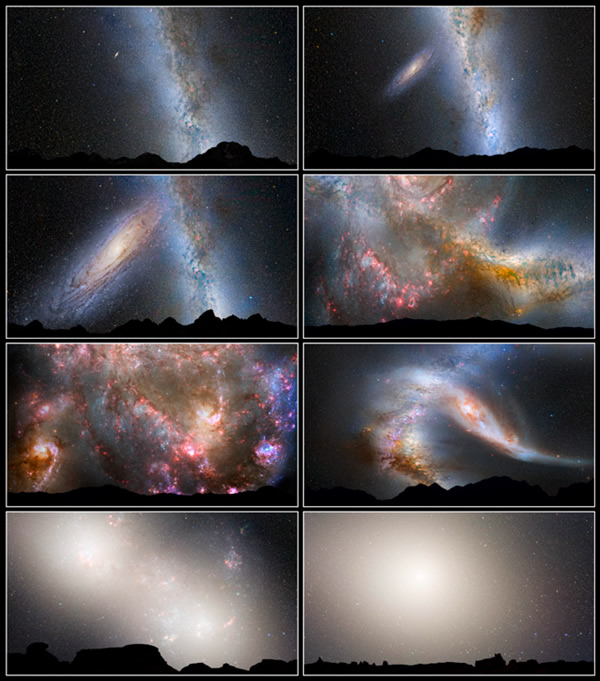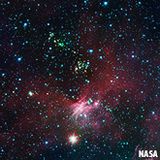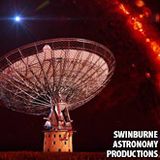
NASA astronomers are predicting with certainty that the Andromeda Galaxy and our home galaxy, the Milky Way, will meet in huge merger event which will affect our entire solar system. But don't pack your bags to leave just yet... it's not scheduled to happen for at least another four billion years.
"Our findings are statistically consistent with a head-on collision between the Andromeda galaxy and our Milky Way galaxy," said Roeland van der Marel of the Space Telescope Science Institute (STScI) in Baltimore.
Astronomers have long speculated that our galaxy and one of the nearest members of our local group were destined to meet, but they were never sure of just how it might happen. Now, thanks to NASA Hubble Space Telescope measurements of the Andromeda galaxy's motion, the answer has become clear. Although it is some 2.5 million light years away, M31 is most surely feeling the force of gravity and moving towards us. It's only a matter of time before we combine.

This illustration shows a stage in the predicted merger between our Milky Way galaxy and the neighboring Andromeda galaxy, as it will unfold over the next several billion years. In this image, representing Earth's night sky in 3.75 billion years, Andromeda (left) fills the field of view and begins to distort the Milky Way with tidal pull. (Credit: NASA; ESA; Z. Levay and R. van der Marel, STScI; T. Hallas; and A. Mellinger)
"After nearly a century of speculation about the future destiny of Andromeda and our Milky Way, we at last have a clear picture of how events will unfold over the coming billions of years," said Sangmo Tony Sohn of STScI.
Approaching us at over two thousand times faster than we're moving toward the Andromeda, it will still be at least four billion years before we combine. By using Hubble data and computer simulations, the scenario shows it will probably take another two billion years after we meet before our pair of interacting galaxies completely merge and reform into a single elliptical galaxy - the most common type in the local Universe.
But even though we'll "smash" head on, the individual stars contained within each galaxy are placed so far apart that very, very few will actually collide. But that doesn't mean there won't be confusion. The stars themselves will be catapulted into different orbits around a new galactic center. The simulations show our solar system will more than likely be much further from the core than at present. To add to the clash of the Titans, the Triangulum Galaxy - M33 - will also join in the fun. There's even a possibility that M33 may be the first to interact with the Milky Way.
What causes these huge cosmic collisions? Our Universe is constantly expanding and accelerating. Galaxies which reside close to each other are locked into place by the gravity of the dark matter which envelopes them. Through the Hubble Space Telescope's deep views, we're able to look back in time to see that encounters of this type were once commonplace when the Universe was smaller. Only a century ago, astronomers weren't aware the Andromeda galaxy was a separate entity - far beyond the reaches of the Milky Way. Edwin Hubble was the first to measure its distance by using a Cepheid variable star - a type of star that now serves as a "mile post" for cosmic distances. Hubble went on to discover the Universe was expanding... its many galaxies fleeing away from us.
Even so, it has long been known that M31 was moving our way at a speed of a quarter of a million miles per hour. That's a speed fast enough to make 12 round trips to the Moon in just one day! How did we know? Thanks to the Doppler Effect, we were able to measure the changes in frequency and wavelengths produced by a moving source and measure the compression of the starlight caused by Andromeda's motion.
Before this latest data set, it wasn't clear whether our combining future would be a side-swipe or a head-on blow. A lot depended on M31's tangential motion. Only recently have astronomers been able to measure the sideways motion necessary to make the call. The Hubble Space Telescope team, led by Roeland van der Marel, was responsible for the incredibly detailed amount of work it took to determine this motion.
"This was accomplished by repeatedly observing select regions of the galaxy over a five- to seven-year period," said Jay Anderson of STScI.
"In the 'worst-case-scenario' simulation, M31 slams into the Milky Way head-on and the stars are all scattered into different orbits," said team member Gurtina Besla of Columbia University in New York, N.Y. "The stellar populations of both galaxies are jostled, and the Milky Way loses its flattened pancake shape with most of the stars on nearly circular orbits. The galaxies' cores merge, and the stars settle into randomized orbits to create an elliptical-shaped galaxy."
Thanks to the space shuttle's servicing missions over a year ago, the Hubble Telescope has been upgraded with even more powerful cameras. This new equipment is responsible for allowing astronomers a sufficient amount of time to get the crucial measurements required to solidify M31's motion.
What would it look like if hundreds of thousands of years passed like seconds? Imagine the scene from Earth... The magnificent Andromeda Galaxy would start off being a small, smudgy stellar patch that accompanied the Sagittarius arm of the Milky Way in the night sky. As you watched, it would draw closer and closer - getting larger and larger. Rather than an indistinct haze, you would begin to see its galactic features, such as the brilliant core region and dark dust lanes. As it closes in on us, distant nebulae and star-forming regions would no longer need a telescope... the outer spiral arms becoming as distinct as our own. As they meet, chaos would ensue. Changes in gravity would push stars into new orbits and familiar constellations would no longer exist. The night would shine with the light of hundreds of thousands of new stars. Slowly, yet surely, the mixture would gradually calm once again. However, instead of the familiar spiral arms, the sky would hold the even light of an elliptical structure... like living on the edge of a huge globular cluster.

This series of photo illustrations shows the predicted merger between our Milky Way galaxy and the neighboring Andromeda galaxy. (Credit: NASA; ESA; Z. Levay and R. van der Marel, STScI; T. Hallas, and A. Mellinger)
It's the real clash of the Titans, and it will one day happen. We'll become the Andromeda Way!
Original Story Source: NASA Hubble Space Telescope News Release



















